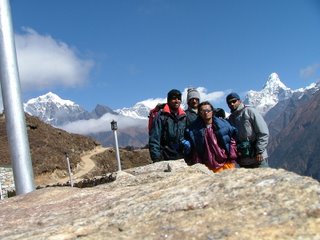Inching Closer To Reality
*** BLOG SITE UNDER CONSTRUCTION AS YET *** TO DO: PROOF READING, FINAL EDITING TOUCHES AND ADDING IMAGES
A Personal Account Of The Mount Everest Base Camp Trek (South Face, Nepal) in November 2004
Wednesday, March 15, 2006
Sunday, March 12, 2006
Sharing the success story..
Anup Mathkar
Vinod Sairaman
The trek organisers whom we were taken to, for obtaining flight tickets from Kathmandu to Lukla. After sharing our trek itinerary plans with them and talking to Mr. Rajendra Bajgain (Raj, as we call him), we felt the services they were offering would help us in successful completion of the trek that meant a lot to us. Our guide (Rawal bhai, as mentioned above) happened to be working for this organisation, and it was Raj who introduced us to Rawal bhai and set us on course. I do appreciate the services provided to us by Gurkha Encounters, and therefore they deserve a special mention here.
Those who mattered the most
Dedicated to
Chandrika Srinivasan
With special thanks to
Madhukar Bhatia
Geetalekha Prabhu
Amit Punde
Harpreet Singh Gandhi
